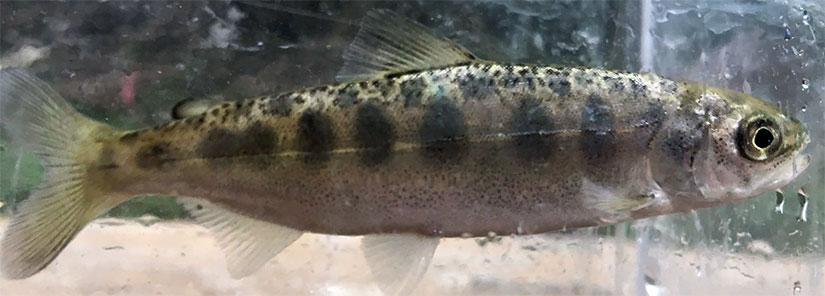Breadcrumb
Chinook Salmon

Chinook Salmon (Oncorhyncus tshawytscha)
Russian River Chinook are part of the California Coastal Evolutionary Significant Unit (CC ESU). They were listed as threatened in the watershed in 1999, but it is debated whether current populations of Chinook are actually native to the Russian River watershed or whether they naturalized after moving in from nearby systems. Historical data is sparse, but it is thought that Chinook may have been extirpated from the Russian by the late 1800s, as multiple stocking efforts were implemented beginning in 1881. These efforts proved unsuccessful, so stocking ended in 1980 and the Warm Springs Hatchery Chinook program ended in 1999. Most stocked fish were from the Klamath and Sacramento systems, but the Chinook that persists in the watershed today is unrelated to either strain, which supports the theory that other CC ESU fish repopulated the basin.
Chinook spawn in the mainstem river and the larger tributaries. Russian River Chinook are fall-run, meaning they generally enter the river system and spawn in the fall, though the onset and amount of rain each year play a large role in determining migration timing. As long as the mouth of the river is open, Chinook can move in as early as August and as late as January
- Life History
-
- Chinook salmon begin their lives as eggs under gravel in a redd where they incubate and hatch out as alevin.
- Alevin remain in the gravel for an additional 3-6 weeks absorbing their yolk sack and then emerge as young-of-the-year (yoy).
- Fall-run Chinook spend just 3-4 months in their natal streams before leaving freshwater prior to the summer.
- Chinook will often utilize estuaries during smoltification, in which their bodies undergo a series of physiological changes to prepare for the transition into salt water.
- They migrate to the ocean, where they will remain until they return as adults—usually as three or four year-olds.
- There are exceptions where some fish return in their second year. These are usually precocious males called “Jacks”, but can also be females known as “Jills”.
- Chinook return to the Russian River to spawn as early as August and as late as January
- After finding suitable spawning grounds, the female will dig a redd while a male guards her. They will die within days of spawning.
- Identifying Characteristics
-
Juveniles
- Parr marks are wider than the spaces in-between them.
- Square anal fin.
- Dark leading line on dorsal fin.

Chinook juvenile Adults
- “Popcorn” shaped spots on back.
- Round spots on dorsal fin and upper and lower lobes of caudal fin.
- Black gums/mouth.
- Large size: 70-100 cm.
- Little change when in spawning form, usually turn brownish green, sometimes red.
Adult male Chinook - Range
-
California Coastal Chinook salmon range from Redwood Creek in Humboldt County south to the Russian River.
- Habitat
-
Chinook spawn mostly in the mainstem of the Russian River and its larger tributaries, like Dry Creek. They need:
- Cold (<20°C) clean water for at least winter and spring before Chinook migrate out.
- Diversity of instream habitats (riffles and pools).
- Complex cover like large woody debris and deep undercuts to hide in.
- Abundance of spawning gravel with low amounts of silt.
- Low to moderate gradient streams without migration barriers.
- Intact estuary habitat.
- Fun Facts
-
- Chinook Salmon are the largest salmon species, reaching lengths up to 52” and weighing 126 pounds. (CA record weighed 88 lbs.).
- Chinook are the most abundant salmon in California, but the least abundant salmon species worldwide.
- References and Recommended Readings
-
- Fishes of California, California Department of Fish and Wildlife
- Groot, C., & Margolis, L. (1991). Pacific salmon life histories. Vancouver: UBC Press.
- McGinnis, S. M., & Alcorn, D. (2006). Field Guide to Freshwater Fishes of California.
- The Behavior and Ecology of Pacific Salmon and Trout
- California Fish